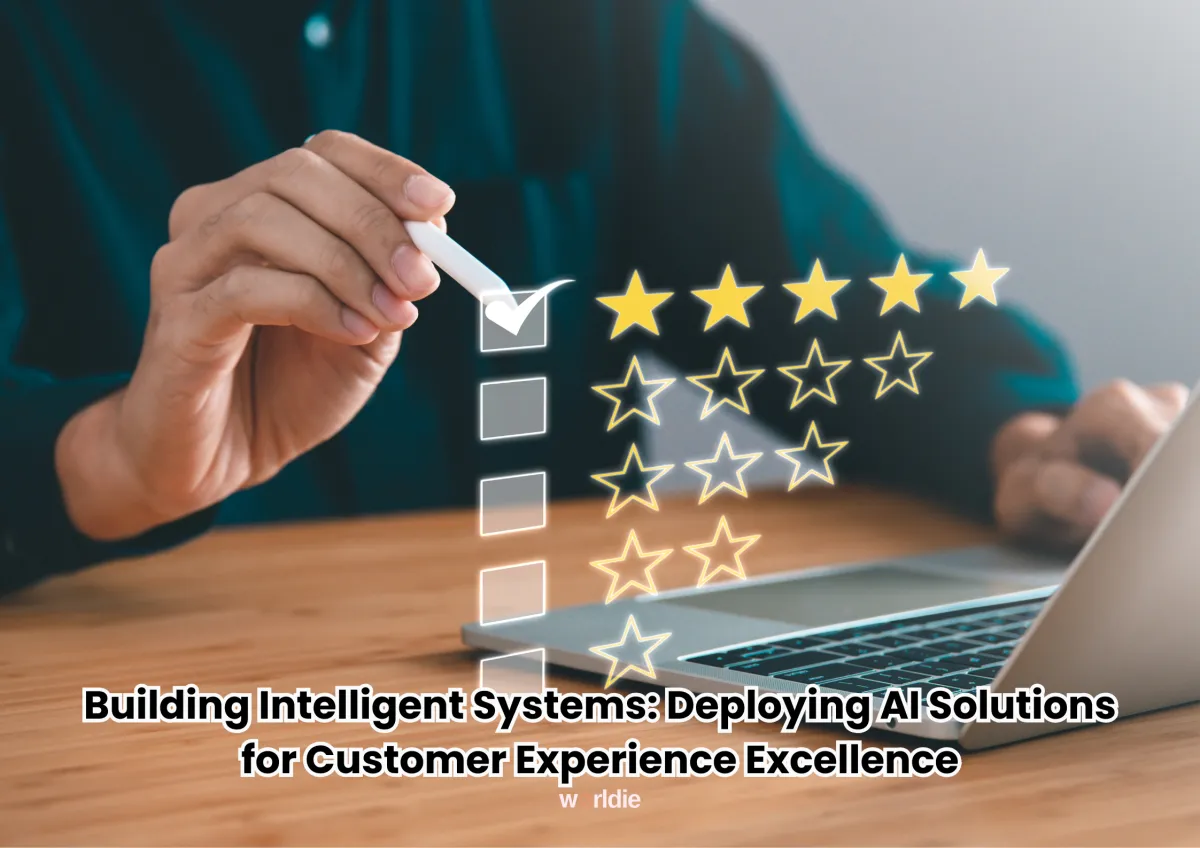
Building Intelligent Systems: Deploying AI Solutions for Customer Experience Excellence
Deploying AI solutions for customer experience excellence is no longer a futuristic idea—it’s a present-day advantage. Businesses that master AI deployment are setting new standards for customer satisfaction, loyalty, and growth. Worldie AI stands at the forefront of this evolution, helping enterprises design and deploy intelligent systems that don’t just respond to customers but anticipate their needs, understand their emotions, and deliver value with every interaction.
Artificial Intelligence has redefined what it means to create meaningful customer experiences. The focus has shifted from efficiency alone to personalization, adaptability, and emotional resonance. When executed properly, AI becomes more than a technology—it becomes a brand advantage.
Understanding What “Deploying AI Solutions for Customer Experience Excellence” Really Means
Deploying AI solutions for customer experience excellence means building intelligent systems that can understand, predict, and respond to customer behaviors at scale. It’s about integrating data, automation, and machine learning into every stage of the customer journey to make experiences smoother, smarter, and more personal.
From Automation to Intelligence
Traditional automation was about replacing repetitive tasks. AI goes several steps further by learning from every interaction, improving its decisions, and adapting its responses to changing customer expectations. This shift turns static workflows into living systems that evolve with customers over time.
The Shift from Service Efficiency to Experience Personalization
Efficiency is valuable, but personalization defines modern loyalty. Businesses that leverage AI to tailor experiences—whether through predictive recommendations, tone-matched messaging, or contextual engagement—build stronger emotional connections and deeper trust.
The Modern Business Challenge: Why Traditional CX Models Are No Longer Enough
Legacy customer experience systems were designed for speed, not intelligence. They can’t deliver the level of insight or adaptability customers now expect. Fragmented tools, inconsistent data, and manual processes create a disjointed experience that undermines customer satisfaction and retention.
The Fragmented Customer Journey
Many businesses operate with disconnected platforms—CRM here, analytics there, and customer service tools elsewhere. This lack of integration prevents a unified view of each customer, leading to slow responses and missed personalization opportunities.
Common Inefficiencies in CX Management
Customer service teams often deal with repetitive questions, inefficient workflows, and limited access to contextual information. These challenges reduce productivity and limit the ability to engage customers meaningfully.
The Cost of CX Blind Spots
Every time a business fails to recognize customer intent or emotional tone, it risks losing loyalty. These blind spots often translate into missed cross-selling opportunities, negative reviews, and diminished brand trust.
How AI Transforms Customer Experience at Every Stage
AI isn’t just changing how businesses interact—it’s changing how they understand and anticipate. From the first click to long-term loyalty, AI shapes each touchpoint with precision.
Anticipating Customer Needs Before They Speak
Predictive analytics allows companies to understand what customers will need before they ask for it. By analyzing patterns in behavior, purchase history, and engagement data, AI systems can trigger the right message or recommendation at the perfect moment.
Elevating Customer Interactions with AI Assistants
AI-powered chatbots and voice assistants have evolved from basic support tools into sophisticated virtual agents capable of empathy, contextual understanding, and escalation management. These systems can handle complex queries and seamlessly hand off conversations to human agents when necessary.
Enabling Real-Time Personalization at Scale
Modern AI models can adapt content, recommendations, and interactions in milliseconds. This real-time personalization ensures that every user feels recognized and understood, regardless of scale.
Streamlining Backend Operations
AI-driven process orchestration can automatically route tickets, prioritize inquiries, and optimize workflows across departments. This not only improves response times but also frees up human teams to focus on high-value interactions.
Industry Use Cases: Deploying AI Solutions Across Sectors
The applications of AI in customer experience are vast and transformative across multiple industries.
Retail and E-Commerce
In retail, AI engines analyze purchase behavior and browsing patterns to create hyper-personalized product recommendations. This leads to improved conversion rates and higher average order values.
Hospitality and Travel
AI helps hospitality brands offer seamless, personalized journeys—from automated check-ins to curated local recommendations. Systems can anticipate a guest’s preferences before they even arrive.
Healthcare and Wellness
AI-powered virtual assistants guide patients through scheduling, follow-ups, and personalized care plans. By interpreting tone and context, these systems can even detect frustration or urgency and respond appropriately.
Financial Services
Financial institutions deploy AI chatbots that combine natural language processing with predictive analytics to provide tailored advice while ensuring regulatory compliance and customer trust.
The Worldie AI Approach: From Design to Deployment
Worldie AI’s framework for deploying AI systems emphasizes strategic design, technical excellence, and measurable outcomes. The process is structured yet adaptable to each organization’s unique goals and maturity.
Step 1 – Design
Worldie AI begins with discovery—analyzing customer touchpoints, data readiness, and business objectives. This phase identifies opportunities for automation, personalization, and intelligence integration.
Step 2 – Build
After design, the team builds custom architectures that align machine learning models with real-world goals. This involves developing scalable infrastructure, integrating APIs, and training AI models with quality data.
Step 3 – Release
Deployment is handled through controlled rollouts, ensuring stability and adoption. Worldie AI uses A/B testing and real-time analytics to measure performance and continuously refine outputs.
Continuous Evolution
AI doesn’t end at launch. The systems Worldie AI builds are designed to learn from user behavior and feedback, continuously adapting to meet evolving customer expectations.
Challenges in Deploying AI for Customer Experience
Every technological transformation comes with obstacles. Understanding them early helps businesses plan effectively.
Data Quality and Accessibility
AI systems depend on accurate, consistent data. Poor data quality can produce biased outcomes, misinterpretations, or inaccurate predictions.
Integration with Legacy Systems
Many organizations struggle to connect outdated infrastructure with modern AI platforms. This challenge requires architectural foresight and expert engineering.
Organizational Resistance
People often fear AI will replace human roles. In truth, AI augments rather than replaces—empowering employees with better insights and tools.
Ethics and Transparency
AI must respect privacy and maintain transparency in decision-making. Ethical deployment is not optional—it’s essential for long-term trust.
Overcoming Deployment Barriers with Strategic AI Architecture
The right strategy turns AI challenges into opportunities for sustainable growth.
Unified Data Pipelines
Creating a centralized data pipeline allows businesses to connect fragmented systems, enabling AI to draw insights from all customer touchpoints.
AI-Driven Decision Engines
These engines process real-time data to make context-aware decisions. Whether it’s recommending products, routing support tickets, or predicting churn, they keep operations adaptive and intelligent.
Continuous Learning Frameworks
Worldie AI builds systems that never stop learning. Continuous feedback loops keep the AI aligned with business goals and customer expectations as markets evolve.
Measuring Success: The Metrics That Matter in AI-Driven CX
AI success must be measurable to ensure accountability and ROI.
CX Performance Indicators
Customer satisfaction scores, resolution times, and sentiment analysis results show how AI improves experience quality.
Revenue Impact Metrics
AI directly affects revenue through improved retention, lifetime value, and conversion rates.
Operational Efficiency
Reduced handling times, automation coverage, and cost savings indicate how well the system optimizes operations.
Real-World Transformation: What Success Looks Like with Worldie AI
AI isn’t a theoretical upgrade—it delivers tangible outcomes. Businesses that adopt AI-driven CX frameworks with Worldie AI report significant gains in both satisfaction and profitability.
A retail client integrated a real-time personalization engine, increasing repeat purchases by double digits. A hospitality partner reduced service response time by nearly half while maintaining customer delight scores above 90 percent. These are not outliers—they represent what’s achievable when technology aligns with intent.
The Future of Customer Experience: Toward Intelligent, Self-Optimizing Ecosystems
The next phase of customer experience will be defined by ecosystems that manage themselves. These self-optimizing systems will detect friction before it happens and adjust interactions automatically. They will not only serve customers—they will understand them intuitively.
Worldie AI envisions a future where businesses no longer chase customer satisfaction but design it into their DNA. With every deployment, they bring this vision closer to reality.
Why Worldie AI is the Partner of Choice
Worldie AI stands apart for its disciplined approach to AI system architecture. Its design–build–release model ensures that every AI deployment is purpose-driven and performance-focused. Businesses partnering with Worldie AI gain access to a scalable foundation that evolves with their customers and drives continuous revenue growth.
The company’s deep technical experience, combined with strategic business insight, ensures that AI is not just implemented—but integrated, measured, and optimized for long-term success.
Frequently Asked Questions
1. What’s the first step to deploying AI solutions for customer experience excellence?
The first step is identifying where AI can make the most impact. Worldie AI begins with a discovery phase that maps the customer journey, evaluates data readiness, and identifies inefficiencies that can be solved with automation or predictive intelligence.
2. How long does it take to implement a full-scale AI CX system?
Implementation timelines vary depending on complexity and data availability. Many organizations see results within three to six months after design and integration phases are complete, with continuous improvement afterward.
3. How can AI balance automation with human empathy in customer service?
AI handles data-driven and repetitive tasks, freeing humans to focus on empathy and emotional intelligence. Worldie AI systems are designed to complement, not replace, human judgment—ensuring balanced and genuine engagement.
4. What challenges should companies expect during deployment?
Common challenges include poor data quality, resistance to change, and integration issues with legacy tools. Worldie AI addresses these with strategic data governance, structured training, and modular architectures.
5. How does Worldie AI ensure measurable business growth through CX AI systems?
Worldie AI aligns every deployment with key performance metrics such as retention, revenue per customer, and operational cost savings. Continuous monitoring ensures that systems evolve and consistently deliver measurable ROI.

